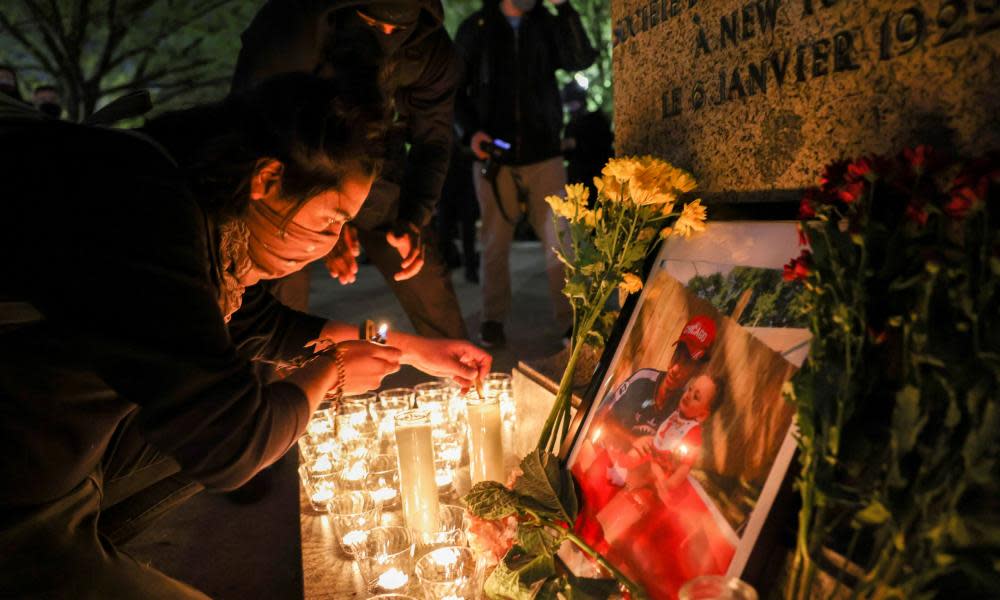Minnesota officer who killed Daunte Wright resigns along with police chief

- Oops!Something went wrong.Please try again later.
Kim Potter, the white Minnesota police officer who fatally shot the Black resident Daunte Wright during a traffic stop, and her chief of police, Tim Gannon, resigned on Tuesday.
Their resignations come after two nights of protests in the Minneapolis suburb of Brooklyn Center over Sunday’s killing of Wright, who was unarmed when he was pulled over for a traffic violation on Sunday.
In a press conference on Monday, Gannon had told reporters that Potter, a veteran officer with 26 years’ service, mistakenly deployed her service issue handgun instead of her Taser as she attempted to stop him driving away.
“I believe it is in the best interest of the community, the department and my fellow officers if I resign immediately,” Potter wrote in a letter to the Brooklyn Center mayor, Mike Elliott, and acting city manager, Reggie Edwards.
Potter also said she had “loved every minute of being a police officer and serving this community to the best of my ability”.
Elliott fired Edwards’ predecessor, Curt Boganey, on Monday, after he countered Elliott’s earlier call for Potter to be fired.
Shortly after receiving Potter’s letter, Elliott hosted a hastily arranged press conference at the Brooklyn Center city hall and said he was “appreciative” that she had resigned, hoping it would “bring some calm to the community”.
But, the mayor said, “We have to make sure that justice is served, justice is done. Daunte Wright deserves that, his family deserves that. Full accountability under the law. That’s what we’re going to continue to work for.”
Elliott also announced that Gannon had stood down. The city commission had voted on Monday night to recommend his termination. Gannon’s deputy, Tony Gruenig, was presented as the city’s new acting police chief at the briefing.
Elliott also called on the Democratic Minnesota governor, Tim Walz, to assign the cause to the state attorney’s office for investigation. It is currently being handled by Minnesota’s bureau of criminal apprehension (BCA), which Gannon said on Monday was not aligned with his decision to immediately publicly release police body-cam images of Wright’s killing.
The sudden senior personnel changes in Brooklyn Center, a suburb 10 miles north of downtown Minneapolis with a population of about 40,000 reflect the growing outrage over police involvement in the killing of Wright, whose family say he was stopped because of an air freshener hanging in his car’s windshield.
At the Tuesday press conference, Elliott appeared to acknowledge community concerns that the suburb’s officers were seen as “outsiders”.
“As of this moment I don’t believe even one of our officers lives in Brooklyn Center,” Elliott said, adding that he thought the department had about 49 sworn officers.
“I do feel very strongly that you need officers to be from the community. There is a huge importance to having a significant number of our officers living in the community where they serve.”
Gruenig was also questioned by activists at the press conference who demanded to know details of the police department’s plans to improve community engagement. One unidentified man said: ““When I watched the video it was triggering. What can you do going forward to make sure this racial profiling does not continue?”
The man added that the small city felt like a “sundown town”, a way of describing a historical term for a white supremacist community where it is made known that people of color are in danger after dark.
“I was only appointed police chief an hour ago. I don’t have a plan,” Gruenig replied, before promising to embark on the process.
Elliott said the new police leadership was committed to working with community leaders and protesters.
“We’re hoping that we’re turning over a new leaf now,” he said. “I’m confident of that now.

